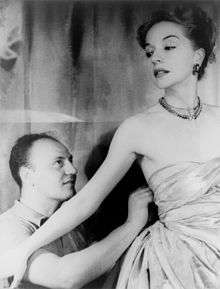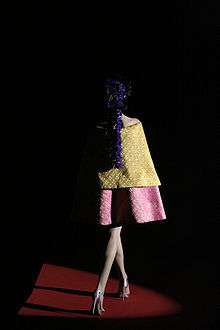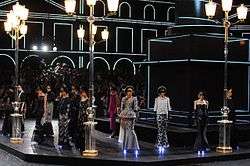Haute couture


Haute couture (/ˌoʊt kuːˈtjʊər/; French pronunciation: [ot kuˈtyʁ]; French for "high sewing" or "high dressmaking" or "high fashion") is the creation of exclusive custom-fitted clothing. Haute couture is high end fashion that is constructed by hand from start to finish, made from high quality, expensive, often unusual fabric and sewn with extreme attention to detail and finished by the most experienced and capable sewers, often using time-consuming, hand-executed techniques. Couture translates literally from French as "dressmaking" but may also refer to fashion, sewing, or needlework[1] - Fashion-Era and is also used as a common abbreviation of haute couture and refers to the same thing in spirit.[2] Haute translates literally to "high". A haute couture garment is often made for a client, tailored specifically for the wearer's measurements and body stance. Considering the amount of time, money, and skill allotted to each completed piece, haute couture garments are also described as having no price tag: budget is not relevant.
The term originally referred to Englishman Charles Frederick Worth's work, produced in Paris in the mid-nineteenth century.[3] In modern France, haute couture is a protected name that may not be used except by firms that meet certain well-defined standards. However, the term is also used loosely to describe all high-fashion custom-fitted clothing whether it is produced in Paris or in other fashion capitals such as London, Milan, New York City or Tokyo. In either case, the term can refer to the fashion houses or fashion designers that create exclusive and often trend-setting fashions or to the fashions created.
French legal status of term
In France, the term haute couture is protected by law and is defined by the Chambre de commerce et d'industrie de Paris based in Paris. The chambre syndicale de la haute couture is defined as "the regulating commission that determines which fashion houses are eligible to be true haute couture houses". Their rules state that only "those companies mentioned on the list drawn up each year by a commission domiciled at the Ministry for Industry are entitled to avail themselves" of the label haute couture.[4] The Chambre Syndicale de la Couture Parisienne is an association of Parisian couturiers founded in 1868 as an outgrowth of medieval guilds that regulate its members in regard to counterfeiting of styles, dates of openings for collections, number of models presented, relations with press, questions of law and taxes, and promotional activities. Formation of the organization was brought about by Charles Frederick Worth. An affiliated school was organized in 1930 called L'Ecole de la Chambre Syndicale de la Couture. The school helps bring new designers to help the "couture" houses that are still present today. Since 1975, this organization has worked within the Federation Francaise, de couture, du Prêt-à-Porter des Couturiers et des Createurs de Mode.[5]
The criteria for haute couture were established in 1945 and updated in 1992. To earn the right to call itself a couture house and to use the term haute couture in its advertising and any other way, members of the Chambre Syndicale de la Haute Couture must follow specific rules; they must:
- design made-to-order for private clients, with one or more fittings;
- have a workshop (atelier) in Paris that employs at least fifteen staff members full-time;
- have at least twenty full-time technical people, in at least one workshop (atelier); and
- present a collection of at least fifty original designs to the public every fashion season (twice, in January and July of each year), of both day and evening garments.
Other uses of the term
The term haute couture has been used in a manner ignoring the legal restrictions, by ready-to-wear brands and in the popular media, since the late 1980s, so that its legal meaning has become blurred—e.g., with that of prêt-à-porter (the French term for ready-to-wear fashion) in the public perception. Almost every haute couture house also markets prêt-à-porter collections, which typically deliver a higher return on investment than their custom clothing. Falling revenues have forced a few couture houses to abandon their less profitable haute couture division, to concentrate solely on the formerly less prestigious prêt-à-porter lines. These houses are no longer considered haute couture houses by the original, legal usage of the term.
Many top designer fashion houses such as Chanel use the word for some of their special collections; these collections are often not for sale, or they are very difficult to purchase.
As well, the term "haute couture" has taken on further popular meanings referring to non-dressmaking activities, such as production of fine art, music, etc.[6]
History

Haute couture can be referenced back as early as the 1700s. Rose Bertin, the French fashion designer to Queen Marie Antoinette, can be credited for bringing fashion and haute couture to French culture.[7] French leadership in European fashion continued into the 18th century when influence was sourced from art, architecture, music, and fashions of the French court at Versailles were imitated across Europe. Visitors to Paris brought back clothing that was then copied by local dressmakers. Stylish women also ordered fashion dolls dressed in the latest Parisian fashion to serve as models.
As railroads and steamships made European travel easier, it was increasingly common for wealthy women to travel to Paris to shop for clothing and accessories. French fitters and dressmakers were commonly thought to be the best in Europe, and real Parisian garments were considered better than local imitations.
A couturier (French: [ku.ty.ʁje]) is an establishment or person involved in the clothing fashion industry who makes original garments to order for private clients. A couturier may make what is known as haute couture.[8] Such a person usually hires patternmakers and machinists for garment production, and is either employed by exclusive boutiques or is self-employed.
The couturier Charles Frederick Worth (October 13, 1826–March 10, 1895), is widely considered the father of haute couture as it is known today.[3][9] Although born in Bourne, Lincolnshire, England, Worth made his mark in the French fashion industry. Revolutionizing how dressmaking had been previously perceived, Worth made it so the dressmaker became the artist of garnishment: a fashion designer. While he created one-of-a-kind designs to please some of his titled or wealthy customers, he is best known for preparing a portfolio of designs that were shown on live models at the House of Worth. Clients selected one model, specified colors and fabrics, and had a duplicate garment tailor-made in Worth's workshop. Worth combined individual tailoring with a standardization more characteristic of the ready-to-wear clothing industry, which was also developing during this period.
Following in Worth's footsteps were Callot Soeurs, Patou, Poiret, Vionnet, Fortuny, Lanvin, Chanel, Mainbocher, Schiaparelli, Balenciaga, and Dior. Some of these fashion houses still exist today, under the leadership of modern designers.
In the 1960s, a group of young designers who had trained under men like Dior and Balenciaga left these established couture houses and opened their own establishments. The most successful of these young designers were Yves Saint Laurent, Pierre Cardin, André Courrèges, Ted Lapidus, and Emanuel Ungaro. Japanese native and Paris-based Hanae Mori was also successful in establishing her own line.
Lacroix is one of the fashion houses to have been started in the late 20th century. Other new houses have included Jean-Paul Gaultier and Thierry Mugler. Due to the high expenses of producing haute couture collections, Lacroix and Mugler have since ceased their haute couture activities.[10]
Modernized haute couture shows are not designed and made to be sold, rather they are exactly what they are displayed for - for show. Instead of being constructed for the purpose of selling and making money, they are made to further the publicity, as well as perception and understanding of brand image.
For all these fashion houses, custom clothing is no longer the main source of income, often costing much more than it earns through direct sales; it only adds the aura of fashion to their ventures in ready-to-wear clothing and related luxury products such as shoes and perfumes, and licensing ventures that earn greater returns for the company. Excessive commercialization and profit-making can be damaging, however. Cardin, for example, licensed with abandon in the 1980s and his name lost most of its fashionable cachet when anyone could buy Cardin luggage at a discount store. It is their ready-to-wear collections that are available to a wider audience, adding a splash of glamour and the feel of haute couture to more wardrobes.[11]
The 1960s also featured a revolt against established fashion standards by mods, rockers, and hippies, as well as an increasing internationalization of the fashion scene. Jet travel had spawned a jet set that partied—and shopped—just as happily in New York as in Paris. Rich women no longer felt that a Paris dress was necessarily better than one sewn elsewhere. While Paris is still pre-eminent in the fashion world, it is no longer the sole arbiter of fashion.
Public and private collections
The largest private collection of haute couture may be that of Mouna Ayoub, whose collection is estimated to encompass more than 1,600 items.[12]
Members of the Chambre Syndicale de la Haute Couture
For the Spring 2016 season the official list of members are:[13]
Official members
- Alexandre Vauthier—Alexis Mabille—Bouchra Jarrar—Chanel—Christian Dior—Christophe Josse—Franck Sorbier—Giambattista Valli—Givenchy—Jean Paul Gaultier—Maison Margiela—Stéphane Rolland—Yiqing Yin[14]
Correspondent members (foreign)
Guest members
- Aouadi—Dice Kayek—Georges Hobeika—Guo Pei—Ilja—Julien Fournié—Ralph & Russo—Schiaparelli—Ulyana Sergeenko—Zuhair Murad—J. Mendel
Jewelry
Accessories
Recent guest members have included the fashion houses of Boudicca, Cathy Pill, Richard René and Udo Edling,[16] as well as Eymeric François, Gerald Watelet, Nicolas Le Cauchois[17] and Ma Ke (Wuyong).[18] In the 2008/2009 Fall/Winter Haute Couture week, Emanuel Ungaro showed as an Official Member.
Former members
- Anna May
- Anne Valérie Hash
- Balenciaga
- Callot Soeurs
- Carven
- Christian Lacroix
- Ektor Von Hoffmeister
- Emilio Pucci
- Erica Spitulski
- Erik Tenorio
- Escada
- Fred Sathal
- Gai Mattiolo
- Germaine Lecomte
- Grès
- Guy Laroche
- Hanae Mori
- Jacques Fath
- Jacques Griffe
- Jacques Heim
- Jean Patou
- Jean-Louis Scherrer
- Jeanne Lafaurie
- Joseph
- Lanvin
- Lecoanet Hemant
- Lefranc Ferrant[19]
- Loris Azzaro
- Louis Feraud
- Lucien Lelong
- Lucile Manguin
- Louise Chéruit
- Mad Carpentier
- Madeleine Vionnet
- Madeleine Vramant
- Maggy Rouff
- Mainbocher
- Mak Shoe
- Marcel Rochas
- Marcelle Chaumont
- Marcelle Dormoy
- Martial et Armand
- Nina Ricci
- Paco Rabanne
- Patrick Kelly
- Paul Poiret
- Philippe et Gaston
- Pierre Balmain
- Pierre Cardin
- Rabih Kayrouz[15]
- Ralph Rucci
- Robert Piguet
- Ted Lapidus
- Thierry Mugler
- Sophie
- Torrente
- Vera Borea
- Yves Saint Laurent
Further reading
- Nudelman, Z. (2009) The art of couture sewing, London, LND, GBR: Bloomsbury Academic, ISBN 1563675390[20]
- Shaeffer, Claire B. (2011) Couture Sewing Techniques, Newtown, CT, USA: Taunton Press, ISBN 1600853358[21]
See also
References
- ↑ https://www.theoddportrait.com/what-is-haute-couture/
- ↑ "What is Haute Couture?". Retrieved 2011-02-19.
- 1 2 Claire B. Shaeffer (2001). Couture sewing techniques "Originating in mid- 19th-century Paris with the designs of an Englishman named Charles Frederick Worth, haute couture represents an archaic tradition of creating garments by hand with painstaking care and precision". Taunton Press, 2001
- ↑ Pauline Thomas. "Chambre Syndicale History and Development - Fashion History". Fashion-era.com. Retrieved 2015-07-15.
- ↑ Calasibetta, C., Tortora, P., & Abling, B. (2002). The fairchild dictionary of fashion. (3rd ed.). New York, NY: Fairchild Books.
- ↑ "Wuyong – Dancing In A Haute Couture Debut | The Fashion Blog". Fashion-blog.us. Retrieved 2015-07-15.
- ↑ Nudelman, Z (2009). The art of couture sewing. London: Bloomsbury Academic. p. 2. ISBN 1563675390. Retrieved 14 July 2015.
- ↑ "Merriam-Webster".
- ↑ Jacqueline C. Kent (2003). Business Builders in Fashion - Charles Frederick Worth - The Father of Haute Couture The Oliver Press, Inc., 2003
- ↑ End of a fairytale: Christian Lacroix fashion house to strip down- The Guardian. Retrieved 21 October 2014
- ↑ Chevalier, Michel (2012). Luxury Brand Management. Singapore: John Wiley & Sons. ISBN 978-1-118-17176-9.
- ↑ Adamson, Thomas (20 February 2014). "Cinderella to Couture Queen: Meet Mouna Ayoub". Associated Press. Gennevilliers, France. Retrieved 13 August 2014.
- ↑ "Haute-Couture Spring Summer 2016 Definitive schedule". Retrieved 2016-03-26.
- ↑ "HAUTE COUTURE - 19 décembre 2011". Retrieved 2011-12-22.
- 1 2 "SS2012 Haute Couture Fashion week designers". Retrieved 2012-01-19.
- ↑ "Haute-Couture Fall Winter 2009/2010 Definitive schedule". Retrieved 2009-07-05.
- ↑ "Haute-Couture Spring Summer 2008 Definitive schedule". Retrieved 2008-06-27.
- ↑ "Haute-Couture Fall Winter 2008/2009 Definitive schedule". Retrieved 2008-06-27.
- ↑ "Haute-Couture Spring Summer 2011 Definitive schedule". Retrieved 2011-02-19.
- ↑ https://books.google.com/books?isbn=1563675390. Retrieved July 14, 2015. Missing or empty
|title=(help) - ↑
External links
| Wikimedia Commons has media related to Haute couture. |
| Look up haute couture or couturier in Wiktionary, the free dictionary. |
- "Haute Couture" from Label France, a magazine of the French Ministry for Foreign Affairs
- Haute Couture at the Metropolitan Museum of Art's Timeline of Art History
- "The Golden Age of Couture". Victoria and Albert Museum. Retrieved 2007-09-13.
- "Interactive timeline of couture houses and couturier biographies". Victoria and Albert Museum.
- Fédération française de la couture
- Christian Dior, an exhibition catalog from The Metropolitan Museum of Art (fully available online as PDF)
- Madame Grès, an exhibition catalog from The Metropolitan Museum of Art (fully available online as PDF)